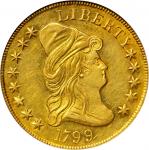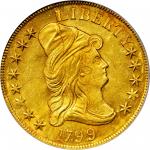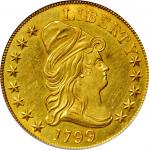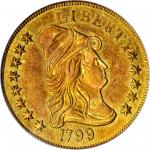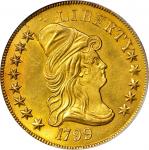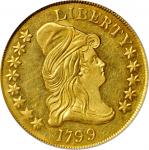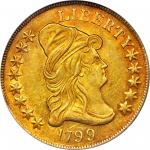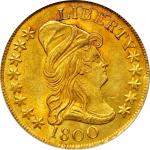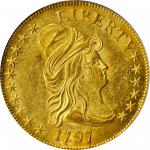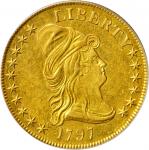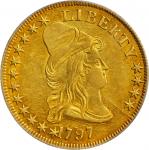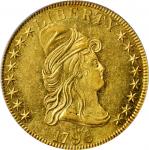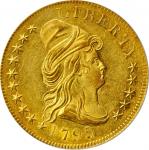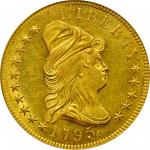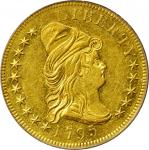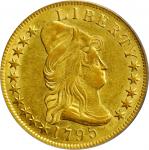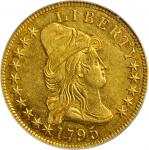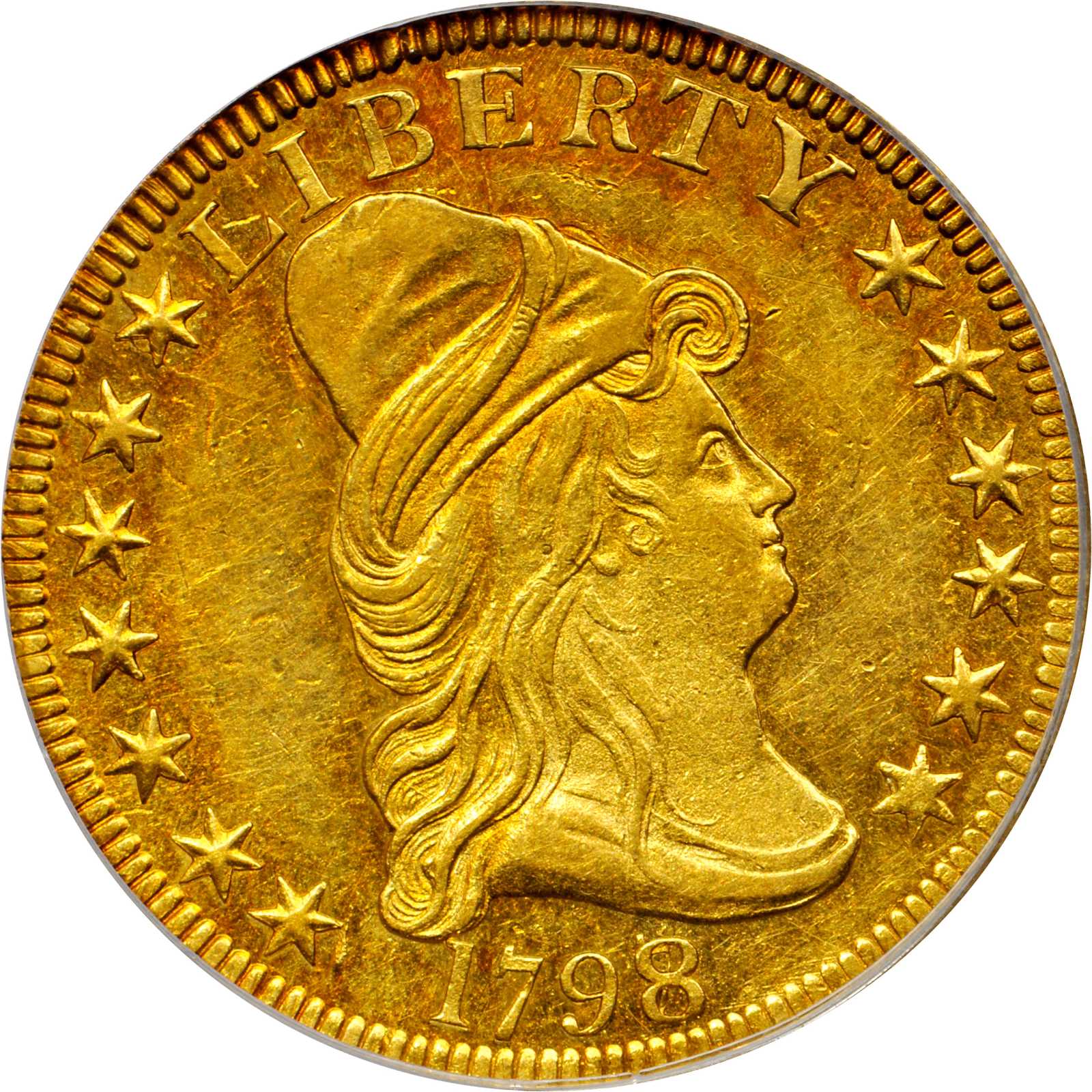1798/7戴帽半身像右鹰金币 PCGS AU 58
1798/7 Capped Bust Right Eagle. BD-2, Taraszka-10. Rarity-6-. Stars 7x6. AU-58 (PCGS).Type and Style: Type II: Capped Bust Right, Heraldic Eagle. Style V: Head of 1795 with 13 stars arranged seven left, six right; Reverse of 1797B with 13 stars in the field below the clouds and a short, thin neck on the eagle. The head punch is attributed to a hub prepared by Robert Scot, while the eagle punch is attributed by some researchers to a hub prepared by John Smith Gardner.Die Variety: BD-2, Taraszka-10, Breen 2-A, HBCC-3181. This variety represents the only use of this obverse die in the Capped Bust Right eagle series, the 7x6 star arrangement definitive. The same reverse die was used to strike both varieties of the 1798/7 eagle, and it was later used by the Mint in the 1797 BD-3 pairing.Die State: BD Die State b/b. Only a single obverse die state is currently known for this variety, Die State a coins with no clashing, lapping or cracks unconfirmed. Die State b, represented here, exhibits three particularly prominent cracks: from the border through the lowermost points of star 7 to the back of Libertys cap; from the field behind the cap, through the cap, hair, split curl and cheek to the chin; and from the upper border through the upright of the letter E in LIBERTY to the top of the cap. All known examples of this variety also exhibit a small die break lump in the lower left obverse field before star 1. There is also only a single reverse die state currently known for this variety, and it is inherited from the 1798/7 BD-1 pairing with light cracks through the tops of the letters UN and TED in UNITED.Estimated Mintage for the Issue: Walter Breen asserts that 1,742 eagles were struck from 1798-dated dies, composed of the 900 coins delivered on February 17, 1798, and the 842 pieces delivered on February 28 of that year. Based on a more exhaustive study of die states and emission sequences, as well as modern estimates on the number of coins extant, Dannreuther provides a broader range of 1,500 to 2,442 coins struck for the 1798/7 eagle as an issue.Estimated Mintage for the Variety: Numismatic tradition accepts a mintage of 842 coins for the 1798/7 Stars 7x6 eagle, based on Breens assertion that the 842-piece delivery of February 28, 1798 was achieved using only this die pairing. Given the paucity of survivors in numismatic circles, however, Dannreuther provides an estimated mintage of 300 to 842 coins for this variety, many of the coins delivered on February 28 likely from the 1798/7 BD-1 Stars 9x4 dies.Estimated Surviving Population for the Variety: Only 20 to 30 coins are believed extant in all grades (per Dannreuther).Strike: This is a well struck early eagle with fully and uniformly denticulated borders around bold to sharp design elements. Softness of detail is minor and largely confined to a few of the obverse stars and the highest points of Libertys portrait and the eagles breast and wings.Surfaces: Originally toned in deep gold, both sides also exhibit pretty reddish-rose highlights around the peripheries. Ample semi-prooflike finish remains, the fields faintly mirrored when viewed with direct lighting. Free of all but wispy handling marks, thin obverse strikethroughs at the border outside the lowest point of star 3 and in the field inside star 6 are the most useful identifying features.Commentary: Like its identically dated BD-1 counterpart, the 1798/7 BD-2 eagle is unique for its obverse star arrangement in the Capped Bust Right ten-dollar gold series. Although this obverse die represents the only use of the 7x6 star arrangement, this actually seems like a more appropriate arrangement than the 8x5 style that replaced it beginning with the 1799-dated coins The 7x6 arrangement allows better centering of the word LIBERTY along the upper border, while on all stars 8x5 obverse dies the word LIBERTY begins in front of the cap and continues far to the right to approximately the 2 oclock position. The scarcity of this variety precludes many numismatists from ever seeing a 1798/7 Stars 7x6 eagle, let alone acquiring an example for their collection. Indeed, after only the 1795 BD-3 9 Leaves, this is the scarcest early eagle die variety produced up to that point in time. The elusiveness of survivors is certainly due to the fact that few coins were struck in the first place. The obverse die failed quickly and developed myriad cracks, as seen on all known examples. It was replaced by the workhorse die of the 1797 Heraldic Eagle issue which, when mated with the same reverse die of both 1798/7 varieties, went on to strike the 1797 BD-3 variety. It was then the turn of the reverse die to yield to a replacement, after which the 1797 BD-4 variety emerged from the press. With the number of coins believed extant suggesting more extensive mintages, both the 1797 BD-3 and BD-4 varieties were likely delivered after February 28, 1798. The 842 eagles delivered on that date probably comprised a small number of 1798/7 BD-2 coins and additional 1798/7 BD-1 examples. As with so many early eagle varieties, the rarity of the 1798/7 Stars 7x6 has been overstated in the past. Breen (1988) asserted that only 13 examples were known. The actual number of survivors is approximately twice that number, which is still small in an absolute sense and confirms this as a very scarce variety. The unique obverse star arrangement places increased variety collector pressure on the few known examples, further highlighting the bidding opportunity represented by the present offering. This coin is included in the list of Significant Specimens for the variety in the Taraszka early eagle reference.From the Anthony J. Taraszka Collection. Earlier ex Colonel E.H.R. Green; Stacks, 1945; our (Stacks) sale of the James A. Stack, Sr. Collection, March 1995, lot 555. The plate coin for the die variety in the book United States Ten Dollar Gold Eagles: 1795-1804 by Anthony J. Taraszka.


